Brief

At a Glance
- Climate change, disease, and technological disruptions are combining to produce more risks—and different types of risk.
- Insurers can look beyond just reimbursing for damages to incentivizing behaviors in ways that will reduce risks.
- Broader use of new technologies will likely help reduce costs and create value for all parties involved, spurring global premiums to $10 trillion by 2030.
- Five core strategic questions around loss prevention, embedded insurance, direct distribution, a China strategy, and alternative capital options will help insurance companies navigate an uncertain future.
Humans have always dealt with risks arising from the natural world and their own behavior. But we appear to have entered a particularly intense period of turbulence (see Figure 1). Climate change, disease, aging populations, and technological disruptions are combining to radically change the risk landscape—both through more risks and different types of risk.
Societies seem to be dealing with more turbulence
The changes thrust insurance companies into new roles. They have the chance, perhaps even the duty, to take a firmer hand in moving beyond reimbursement for damage and controlling losses to incentivizing behaviors in ways that will reduce risks. If they can pull it off, the future of insurance looks bright.
In 2021 alone, a variety of conventional risks (such as flooding in China and Germany and heat waves in the US and Canada) and unconventional risks (such as ransomware cyberattacks on the Colonial gas pipeline) disrupted the lives of many millions of people. Such events, once outliers, are becoming the norm.
The consequences for an underprotected world in 2030 with low insurance penetration, particularly in emerging markets, may be severe. For instance, although climate change–related weather events have reached corporate board and government agendas for years, insurance doesn't cover most losses from natural catastrophes. According to Swiss Re, global economic losses resulting from natural catastrophes between 2011 and 2020 totaled more than $2 trillion, with only about 35% of these losses covered by insurance. Similarly, as the Covid-19 crisis brought into sharp relief, societies are underprotected against health risks; Swiss Re estimates that health protection gaps in Asia alone totaled $1.8 trillion in 2017. A similar story plays out across other coverage lines and regions.
Yet there are grounds for optimism about the future of insurance. The industry now has the tools to help solve these problems on a large scale by 2030, thanks to improved technology and data. Insurers have always played a role in addressing societal risks—for instance, when they were instrumental in lobbying for car safety belts. Now, new technologies, such as the Internet of things (IoT) or machine learning (ML), along with massive data sets on driving behavior and other relevant trends enable insurers to directly partner with customers to identify, prevent, and mitigate each risk event.
For example, several auto insurers today offer telematics solutions that track and incentivize safe driving behavior. Groupama, a French insurer, has seen a 10% to 15% reduction on auto claims in Italy and roughly 800 crashes avoided per year based on its G-Evolution telematics service. Similarly, UK insurer Marmalade, which focuses on insuring young drivers, a historically higher-risk group, uses telematics to help them drive better. The company says only 1 in 18 Marmalade drivers encounters an accident within six months of their policy start date vs. a UK national average of 1 in 5 young drivers. Partnerships can spur companies to roll out these digital tools, as illustrated by Mitti, a joint venture between QBE and SafetyCulture, which measures, rewards, and suggests risk management strategies for workplace safety.
Broader use of these tools will likely spur a collective shift in the industry’s central purpose from loss reimbursement to loss control over the next decade. When coupled with technology-enabled cost reductions and deeper capital pools, this shift will create tremendous value for all parties involved and could propel global insurance premiums to $10 trillion by 2030 (see Figure 2).
Global insurance premiums should grow substantially through 2030
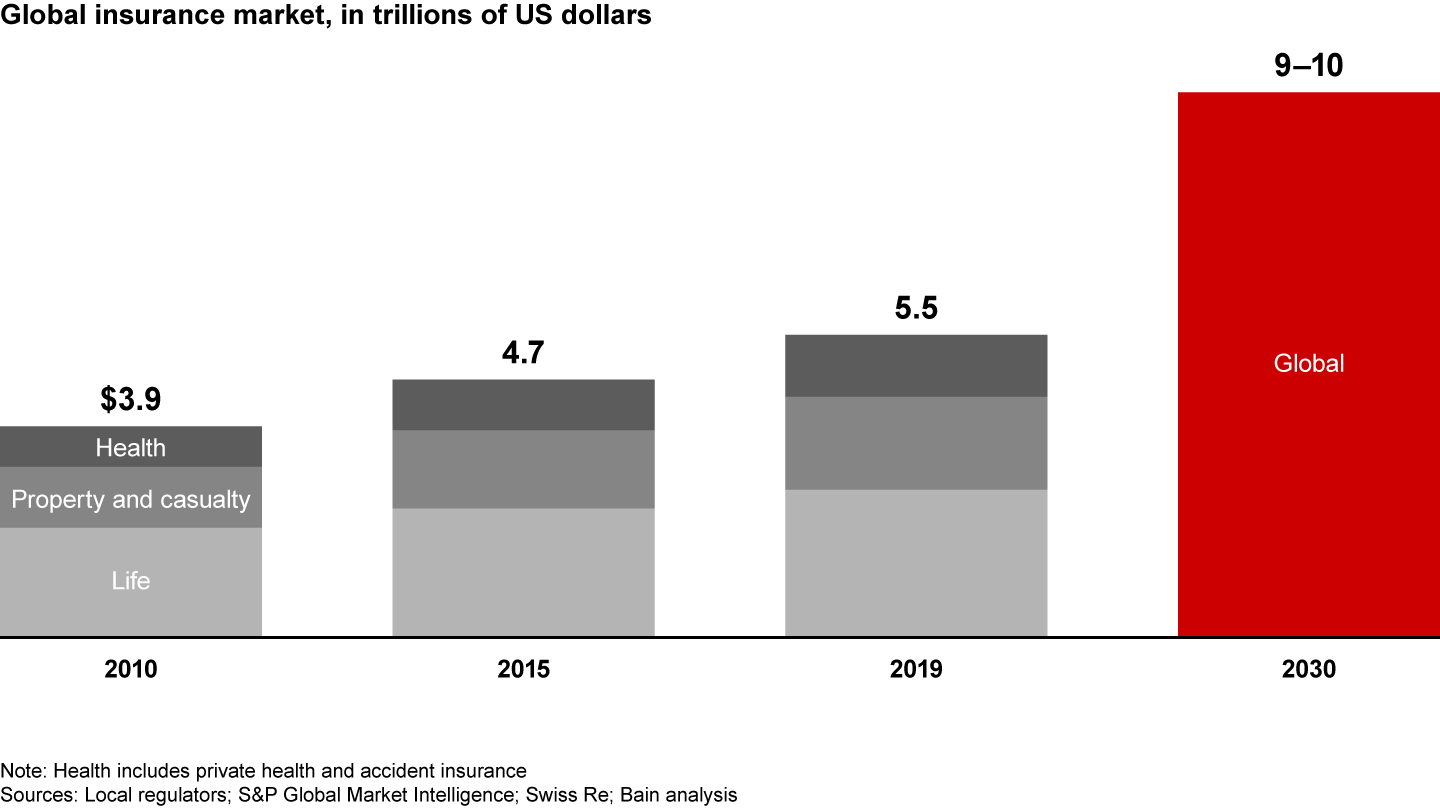
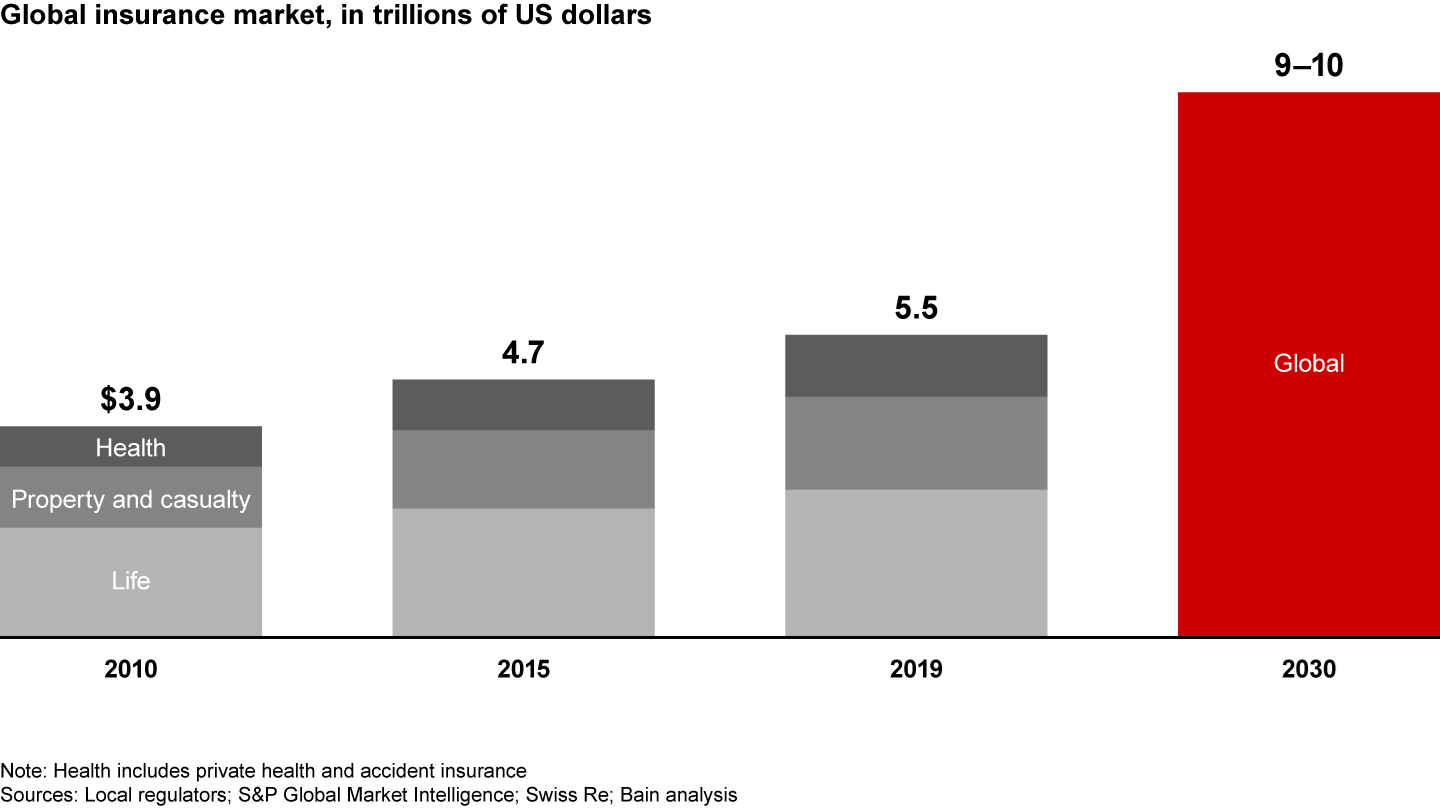
At the same time, the role of insurance companies as well as their relationships with customers, partners, funders, and governments will be fundamentally altered. And the distribution of power and profits across the industry will look very different.
Risk isn’t what it used to be
Besides the overall increase in risks, the profile of risks also is changing. They’re declining or flat in mature areas, such as personal auto, workers’ compensation, and mortality; expanding in new areas, such as cybercrime and digital assets; and growing more severe in others, including climate change and infectious disease. Other relatively new risks, such as how to cushion the economic impact of widespread automation, aren't currently covered by private insurance, but they may well be in the future.
A few numbers illustrate the trends. Road travel is safer than ever, with death rates resulting from motor vehicle accidents in the US per 100 million vehicle miles traveled having declined by about 70% over the past four decades. By contrast, we estimate that climate change will result in a roughly tenfold increase in economic losses (across natural catastrophes, agricultural output losses, energy demand increases, bio ecosystem damage, water stress, health issues, and the like) over the next three decades. During 2020 alone, Munich Re estimates that the US experienced a record number of wildfires (with losses totaling $16 billion) and a record number of storms during hurricane season (with losses totaling $43 billion).
Risk and protection are also shifting geographically toward countries with faster economic growth. China will drive well over a quarter of global premium growth through 2030 (see Figure 3). Yet few multinational insurers have a viable path to participate in China’s insurance markets, particularly in property and casualty (P&C), given intense competition, regulations that favor domestic firms, and geopolitical tensions.
China’s share of global premiums will continue to grow rapidly through 2030
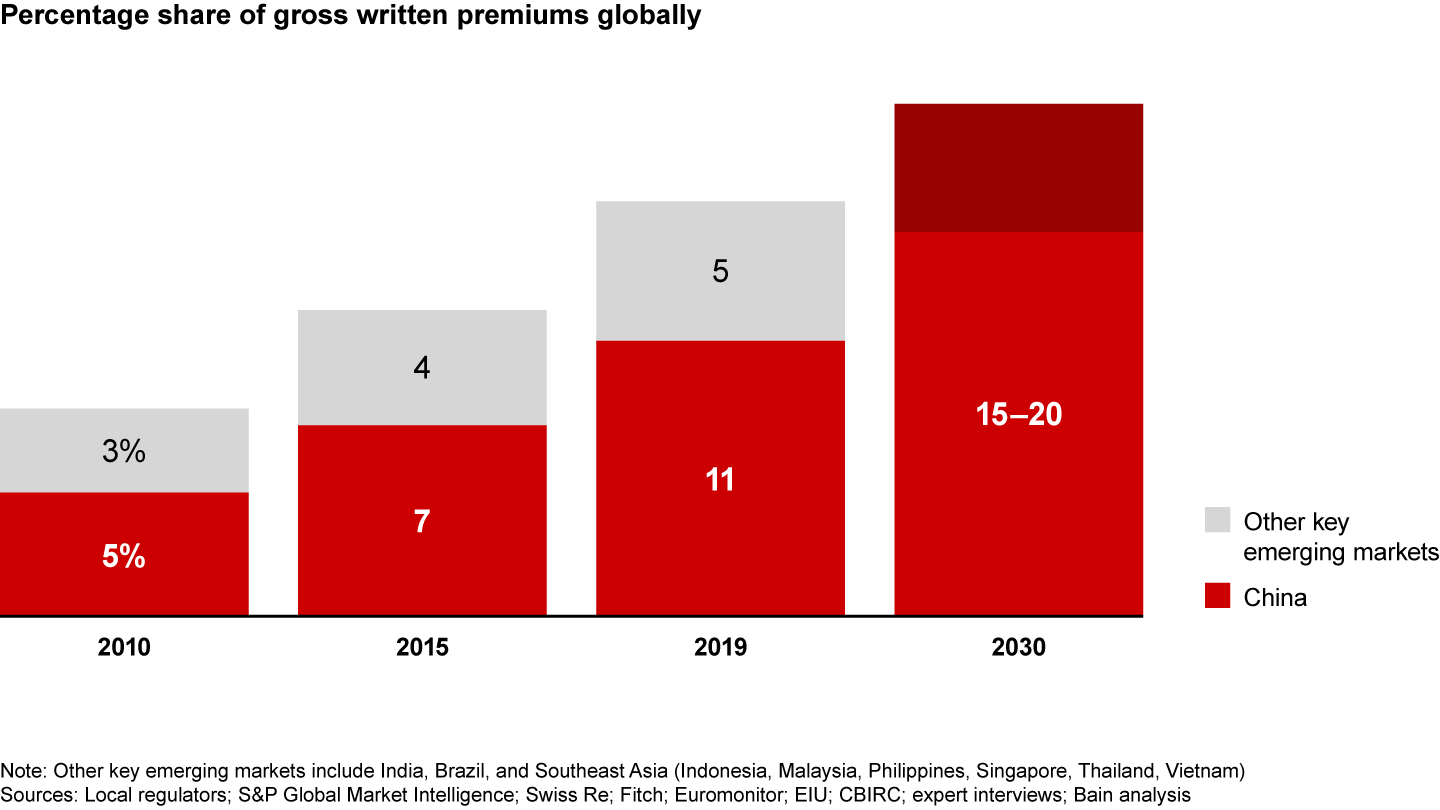
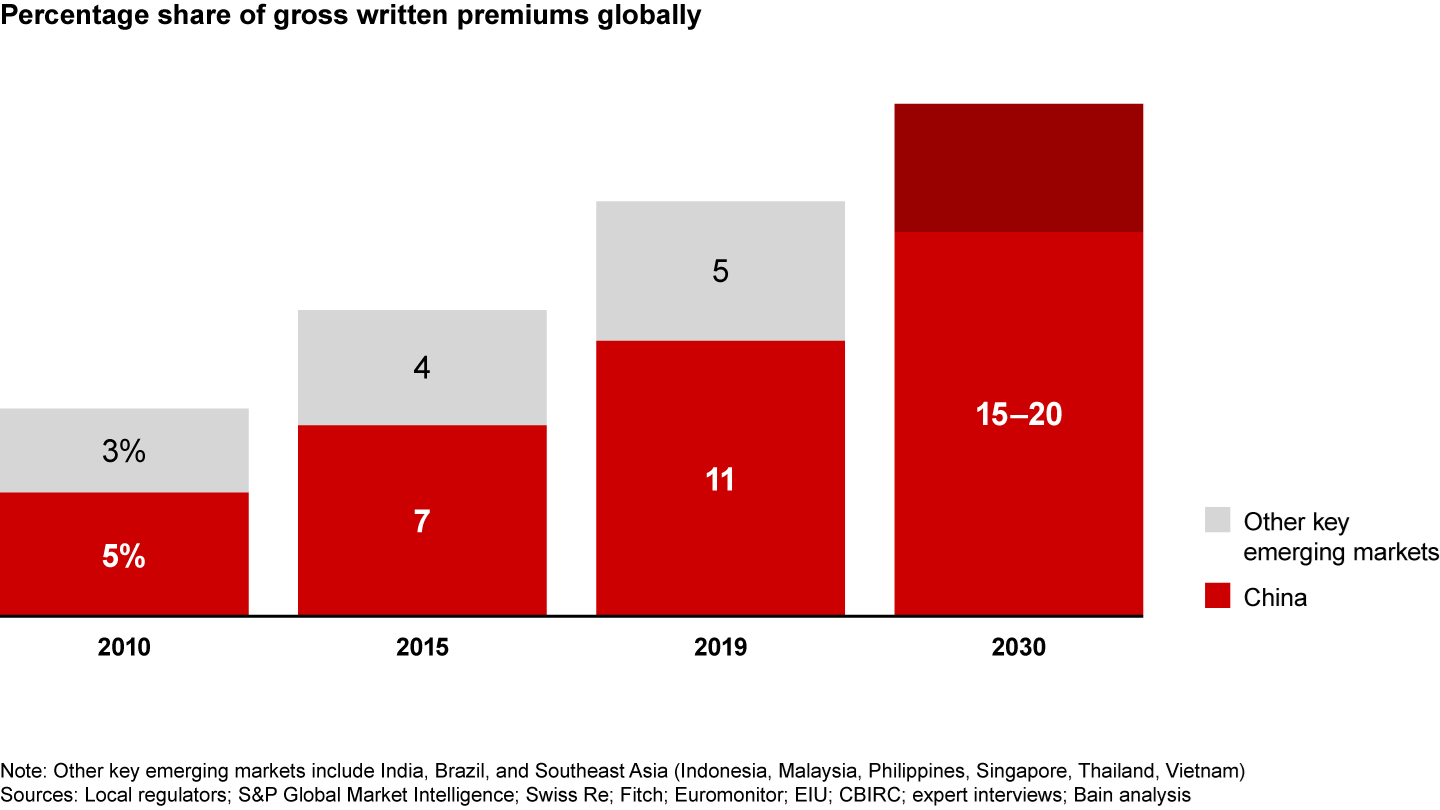
Traditional Western insurance centers, such as London, will face stiffer competition from new insurance hubs, including Singapore, Hong Kong, and Shanghai. India, Southeast Asia, and Latin America offer growth with more accessibility for multinationals, but they'll remain small relative to China. For instance, while India has the largest population after China, its insurance market in terms of gross written premiums (GWPs) is less than one-fifth of China’s, and it will probably contribute only about 3% of global GWP growth between now and 2030.
These emerging markets will also be hotly contested, not least by Chinese insurers. Ping An has been using a technology-led expansion into Southeast Asia via its Good Doctor and OneConnect entities and by partnering with Grab to provide telemedicine services in Indonesia.
Why the cost of protection will decline
Even as the risk landscape is shifting, other trends have combined to help deliver improved protection at a lower cost. Insurer costs are set to dramatically decline across claims, expenses, and funding for several reasons.
- Finer risk segmentation and pricing: New technology and data capabilities have the potential to reduce claims payouts by up to 20% across different lines of coverage. For example, Travelers uses a model for business customers that predicts employees at high risk of chronic pain and suggests changes in the treatment plan. The program can lead to up to 50% in savings on workers’ compensation claims that involve chronic pain. These employees are less likely to suffer from chronic pain, they return to work faster, and need fewer opioids. Similarly, Kinetic, a US-based technology firm, has partnered with AIG and Amerisure to offer wearable devices that help reduce musculoskeletal injuries, reporting a 50% to 60% reduction in injury frequency and a 72% reduction in lost workdays.
- Lower operating expenses: We expect customer acquisition expenses to remain flat. Advances in automation, the IoT, and modular technology architectures, however, will allow insurers to reduce operating expenses by as much as 50% (see Figure 4). Insurtech Lemonade puts artificial intelligence (AI) at the center of its operations through a range of empathetic bots that automate most interactions. Lemonade’s virtual assistant Maya uses natural language processing to collect information, provide quotes, and handle payments. A bot named Jim handles roughly one-third of claims and can approve many claims in seconds while constantly improving its fraud detection capabilities through ML.
- Broader and more varied sources of funding: Private investors are turning to insurance to obtain more permanent capital and returns uncorrelated with other holdings. Private equity funds are steering capital to life and annuity businesses, with several multibillion-dollar deals in 2021, including KKR’s acquisition of Global Atlantic and Blackstone’s acquisition of Allstate’s life business. Similarly, demand is surging for insurance-linked securities (ILS), as illustrated by catastrophe bond issuance doubling in 2020 from the previous year, to reach $11.4 billion. Some insurers are raising a significant share of their capital from these alternative sources; for instance, roughly half of Renaissance Re’s $14 billion capital base comes from third-party capital through instruments, including reinsurance sidecars and ILS.
Alternative funding sources have improved operating performance by raising better investment returns and allocating more capital to better operators, including insurtechs as well as nimble managing general agents and managing general underwriters in P&C. A more liquid marketplace for such investments has the potential to open up insurance opportunities to a broader set of investors, some of which will have lower return targets that could ultimately lead to a lower cost of capital.
Data will benefit insurers by reducing claims and expenses
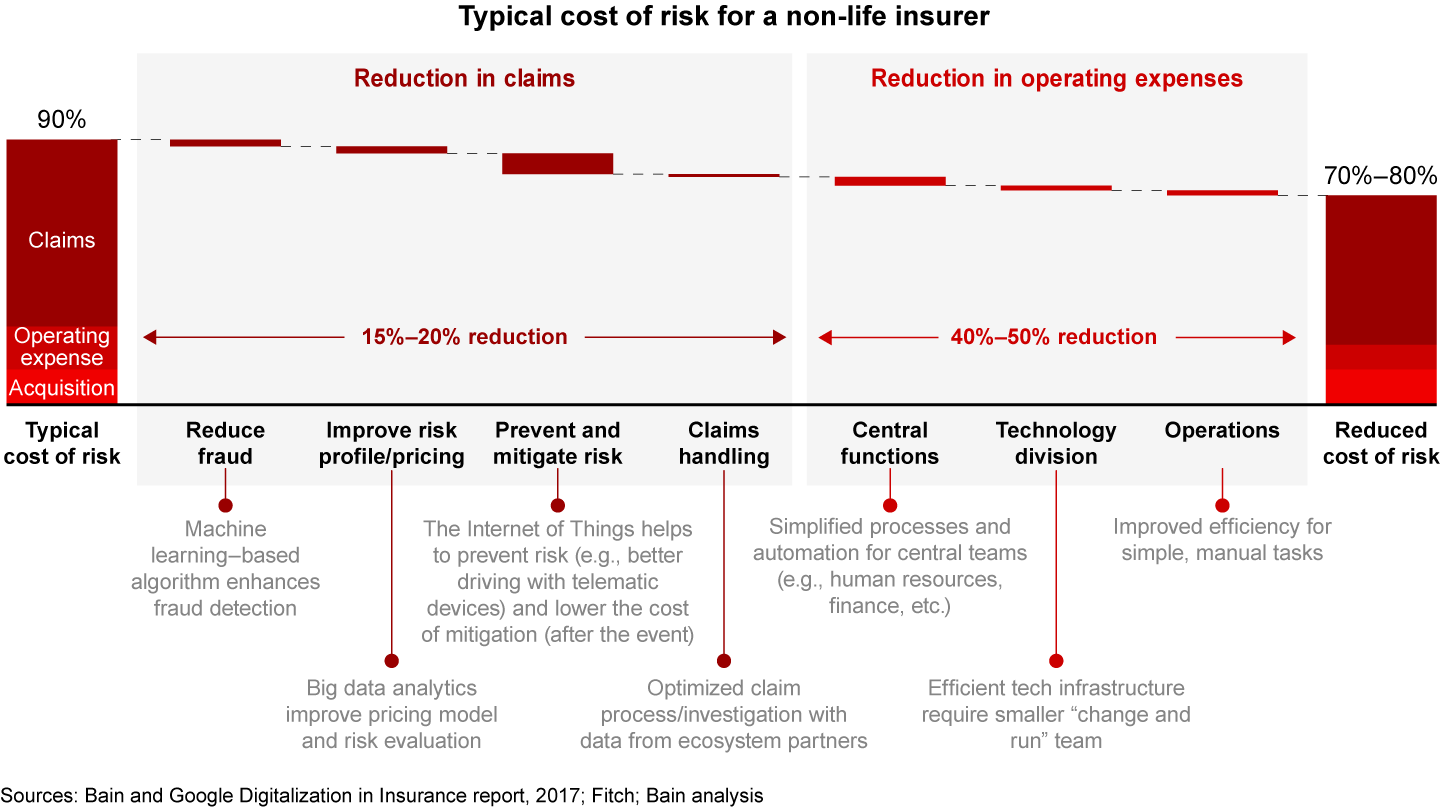
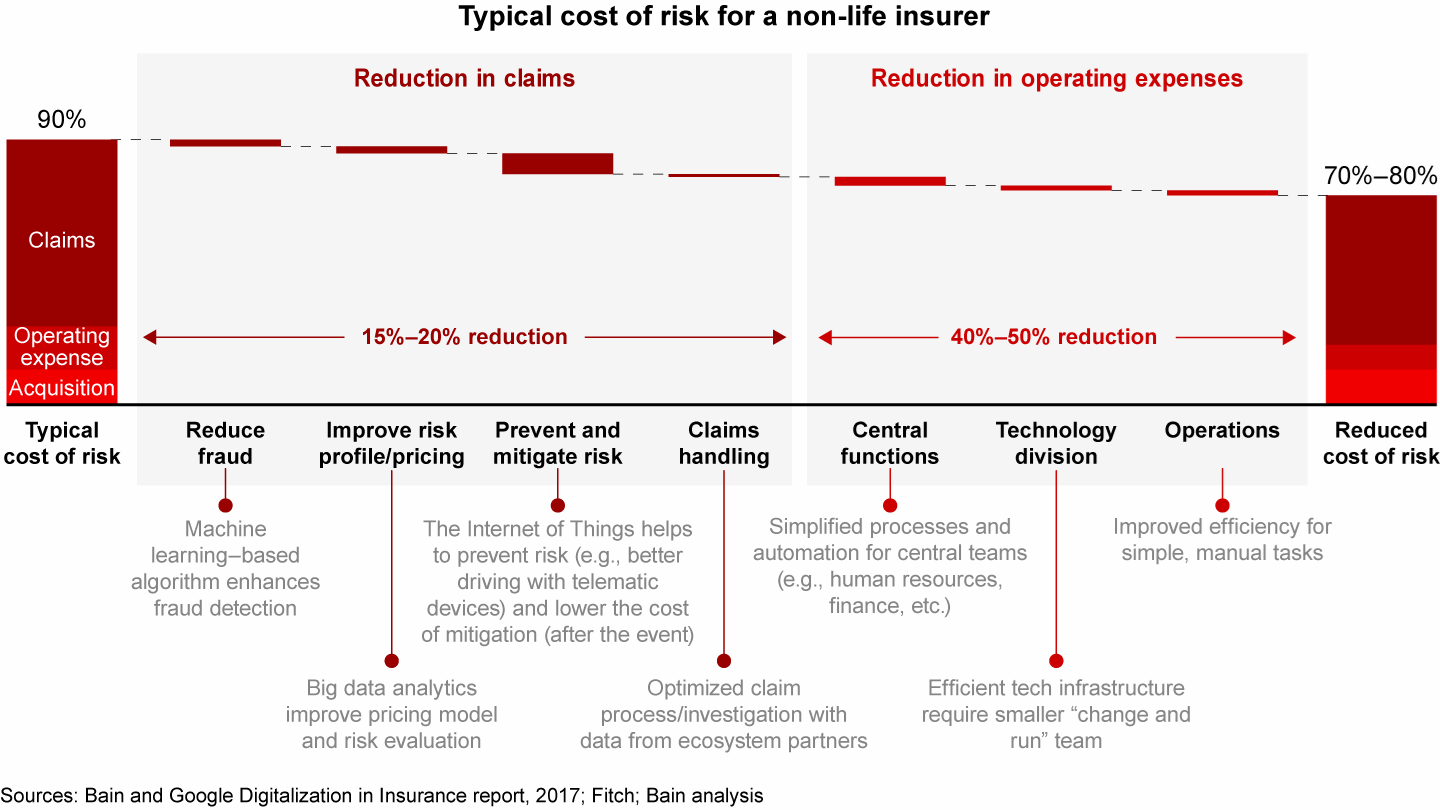
While some of these savings may flow through to profits, competitive dynamics will likely force an overall reduction of prices for protection, at least for the good risks, leading to an increase in the penetration of insurance and faster industry growth.
Good and the bad risks diverge
If technology and data analytics lead to unprecedented gains in how well insurers understand, prevent, and mitigate risks, they're also likely to increase pressure on bad risks, resulting in sharply higher prices or outright unavailability of coverage by 2030. Three issues are at play here. First, extreme segmentation and underwriting price discrimination weakens the subsidies at the core of risk pooling. Second, some risks to property exposures, such as in California (wildfires) and Florida (hurricanes), become too expensive to cover. And third, public pressure intensifies on out-of-favor sectors, such as carbon-intensive energy producers (see Figure 5).
Some climate risks have recently prompted insurers to reduce coverage
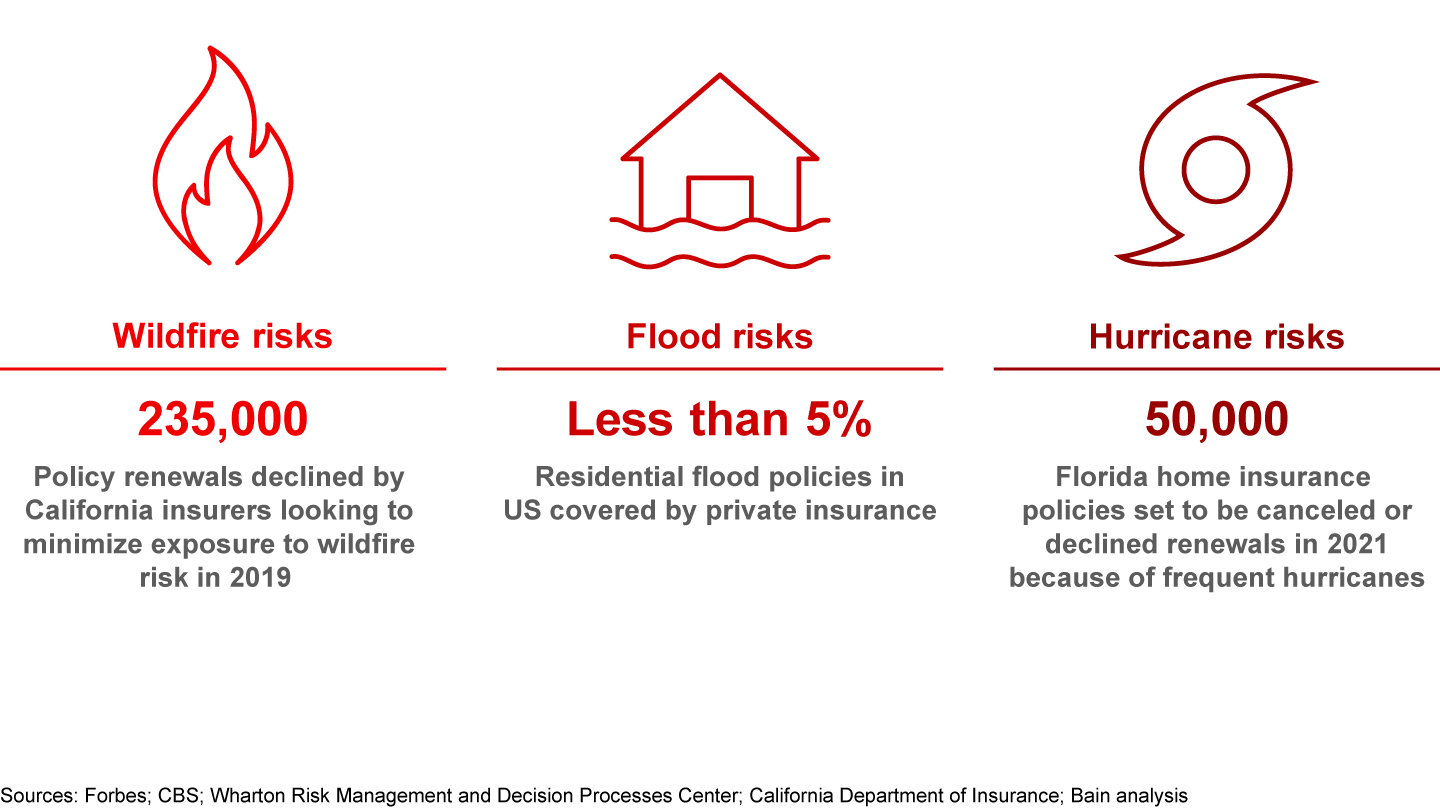
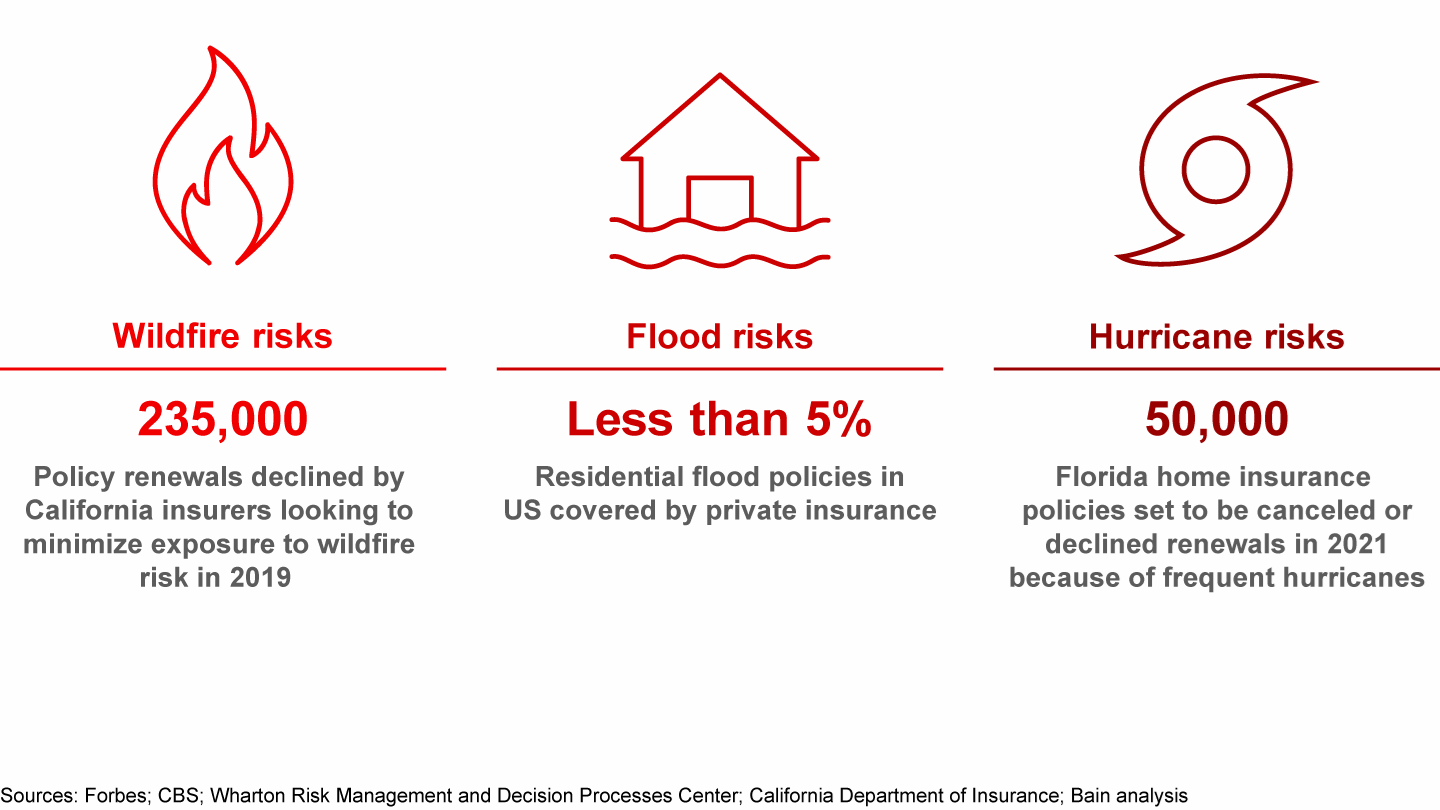
Depending on the extent to which this trend plays out, governments may intervene with stricter rules around data access and usage, increased regulation of underwriting practices, or expanded use of assigned risk pools and public-private partnerships to ensure protection of the most vulnerable people. Interventionist precedents are common. In 2016, the Chinese government set up a partnership with global reinsurer Swiss Re and local insurer Sunlight Agricultural Mutual to protect farmers in 28 low-income counties for losses caused by natural disasters. Similarly, in cyclone- and flood-prone Northern Australia, outsized premiums have prompted the federal government to establish a $10 billion reinsurance pool from 2022 onward that is aimed at ensuring access to protection.
The further rise of new competition
These shifts in what we need to protect against and how we do it have disrupted traditional insurance value chains. Sensing the opportunity and emboldened by the possibilities offered by new technologies, particularly AI, ML, IoT, distributed ledger, and modular technology architectures, a variety of upstart insurtechs, big technology platforms, and leaders in other industries (such as auto manufacturers) are targeting the most lucrative parts of the value chain with new business models. As a result, insurance capabilities are unbundling, which calls into question the role of the traditional, integrated insurance company.
A relatively new business model, embedded insurance, has become more prominent in certain personal lines to offer insurance at point of sale. Chubb, for instance, has partnered with ride-hailing company Grab in Southeast Asia to make accident coverage available for all riders while booking a trip. This will be a double-edged sword as the avenues for selling insurance expand, but the insurer forfeits the customer relationship to the distributor.
A host of insurtech companies have sprung up to provide embedded services and have attracted venture capital investors. Extend, Element, Qover, Boost, and Wrisk are providing services that allow any business to integrate insurance into its offerings, and all of them raised venture funding in the first quarter of 2021 alone.
Similarly, big technology firms have shown interest in embedded insurance for a longer period. These range from the conventional (such as the AppleCare proposition to provide coverage on its Apple devices) to emerging flavors (such as Amazon partnering with Next Insurance to offer small business insurance to Amazon Business Prime members).
Penetration of embedded insurance will also vary significantly by line in the future. The greatest penetration will initially come, we believe, in three lines: auto (such as insurance embedded by automakers into the car sales process), travel (through insurance built into flight or hotel bookings), and property (including renters' insurance). Some industry analysts estimate that the total size of embedded GWP in P&C will reach $700 billion by 2030.
In parallel, insurtechs and traditional insurers will access more capabilities as a service in the future while keeping their core competencies and distinctive capabilities, such as branding and underwriting, in house. For instance, Allianz uses Cyence’s cyber analytics platform to assess a corporate customer’s cyber risk profile before tailoring coverage to the customer’s needs.
The ascent of embedded insurance and capabilities as a service will reshape the industry by 2030. Certain insurers might seek to build scale in specific activities, such as customer acquisition or funding, and excel in those activities across coverage lines and customer segments. We might see the return of multiline models for companies that control the customer relationship, as is already occurring among insurtechs with strong customer acquisition and customer experience capabilities slowly expanding their offering across lines. Lemonade, for example, started with property insurance and used its strong capabilities in customer experience to expand to auto, pet health, and term life insurance.
Similarly, in the future we also envision more insurance companies going well beyond their traditional core offerings. For example, Ping An’s Good Doctor service has grown to become China’s largest telemedicine provider, with more than 72 million monthly active users. These kinds of direct service delivery will require large scale and thus be practical options for only a few companies.
Partnerships will emerge as a more important element of competition as insurers become more modular. Chubb has developed a set of application programming interfaces that allow its partners to easily integrate Chubb’s insurance products into their platforms. DBS Bank in Singapore, for example, used Chubb Studio to develop and deploy Mozzie Protect, insurance against dengue fever.
Five questions to help navigate the future
While the direction and future of the insurance industry are becoming clearer, the speed and extent of change through 2030 will depend on the pace of technology adoption, the extent of regulatory changes, customer preference shifts, and macroeconomic factors.
A range of outcomes is possible. The greater availability of more relevant data could allow for highly accurate pricing of risks down to the individual customer level, which, in turn, could challenge the fundamental risk pooling nature of insurance. More standardized investment vehicles could create a deeper, more liquid market for investors to access insurance, further blending protection with asset management. Direct distribution channels might fully replace traditional broker-led models in certain lines and even avoid disintermediation via platforms.
To succeed in this radically different future, executive teams will benefit from conducting a holistic review of their strategy. Many of the specifics will vary across sectors and markets, but a few broad strategic questions apply to virtually all insurers.
- How should we interact with customers to prevent and mitigate risks? Going beyond risk transfer to risk mitigation and prevention will be critical for insurers, customers, and regulators in a riskier world. There are several means to do this, requiring new capabilities and likely a broader range of partnerships.
- Should we participate in embedded insurance? Certain lines, such as mobility, will inevitably include embedded insurance. Each carrier must decide whether to actively promote it, reject it, or something in between. Foregoing a tight relationship with the customer might seem scary, and the economics not immediately clear. But failing to secure the right partnerships could be costly once embedded insurance goes mainstream.
- Do we need direct customer distribution? With increased competition from insurtechs that market directly to customers, several incumbents are launching digital attacker models to increase their share of direct business, bypassing broker-led models. This can be a suitable hedging strategy in certain lines amenable to direct channels as long as an insurer has weighed considerations, including the level of disruption in the market, its ability to innovate within the core business, and potential channel conflict with the core business.
- Do we need to be in China? If so, how? If not, where else should we focus for growth? Winning in China has proven quite difficult for multinational carriers. Although they've gained share in life and health lines, capturing about 8% of the market, in recent years, they've struggled in P&C, capturing just 2% of the market. Meanwhile, multinationals have also struggled to deliver top-quartile shareholder returns, and they're streamlining their geographic and product exposure to make fewer, bigger bets. A focused intentional strategy for China thus has become critical.
A careful China strategy would assess the firm’s overall growth ambition, its existing presence and standing in China, its appetite to play the long game, and its ability to build contingencies in case geopolitical tensions escalate. At the same time, each firm should consider alternative growth regions and alternative products and customer segments.
- How aggressively should we explore alternative capital options? Alternative sources of capital increasingly will become available to insurers, particularly as a form of reinsurance in catastrophe bonds and other lines, and through private equity investments in life and annuities businesses. To assess their funding strategy, insurers should consider the packageability and attractiveness of risks in their portfolio, the type of investors and instruments that would suit them, and the potential effect of alternative capital on their cost of capital and business strategy.
While not exhaustive, this set of high-gain questions serves as a useful starting point for senior executive teams strategizing for their future. The door is open for incumbent and new firms alike to define new roles in prevention and mitigation in a world of more extreme risks.